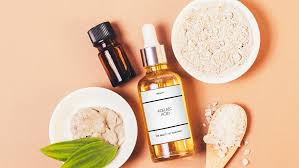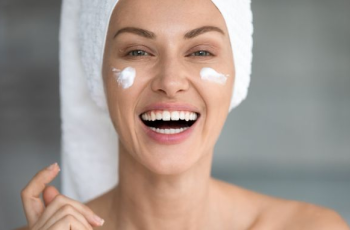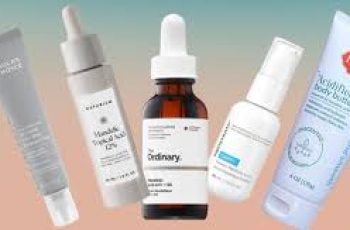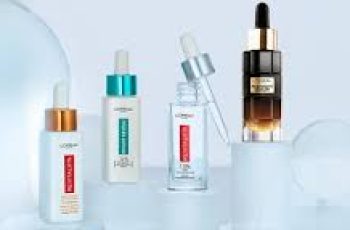
.webp)
.webp)
.webp)
How Long Can You Use Azelaic Acid For?
.webp)
.webp)
Azelaic acid has quietly emerged as one of the most revered skincare ingredients in recent years.
.webp)
.webp)
.webp)
Dermatologists and skincare experts alike swear by its multiple benefits, ranging from treating acne to calming rosacea, all while being gentle enough for sensitive skin.
.webp)
.webp)
This powerhouse ingredient can now be found in a wide variety of products, many of which have made their way into everyday skincare routines across the globe.
.webp)
.webp)
.webp)
Azelaic acid, a naturally occurring compound, is primarily found in grains such as wheat, barley, and rye.
.webp)
.webp)
Known for its ability to address both acne and rosacea—a combination few other active ingredients can boast—azelaic acid offers a solution to people with sensitive or reactive skin.
.webp)
.webp)
.webp)
Whether you’re new to this ingredient or already using it, you might be wondering: How long can you use azelaic acid for? Let’s explore the answer to this important question.
.webp)
.webp)
Can You Use Azelaic Acid Long-Term?
.webp)
.webp)
.webp)
The duration for which you can use azelaic acid largely depends on the formulation of the product you are using. This is because different formulations vary in strength, with some being more potent than others.
.webp)
.webp)
Prescription-strength azelaic acid products typically contain concentrations of 15%-20%, making them more powerful, and therefore, requiring more careful application as prescribed by a doctor or dermatologist.
.webp)
.webp)
.webp)
For over-the-counter products, which generally contain lower concentrations of around 10% or less, you can use them more freely and even combine them with other actives that suit your skin type.
.webp)
.webp)
These products can typically be applied twice a day as part of a regular skincare regimen, and many users find they can safely use them for extended periods of time without side effects.
.webp)
.webp)
.webp)
That said, it’s important to remember that everyone’s skin is unique, and what works for one person may not work for another.
.webp)
.webp)
If you’re new to azelaic acid or considering incorporating it into your skincare routine, it’s a good idea to consult a dermatologist to ensure it’s the right fit for you.
.webp)
.webp)
.webp)
When Should I Stop Using Azelaic Acid?
.webp)
.webp)
Although azelaic acid is known for being gentle on the skin, it’s essential to monitor your skin’s response, especially when introducing any new active ingredient.
.webp)
.webp)
.webp)
Patch testing is recommended to check for potential irritation or allergic reactions before you use azelaic acid over a larger area of your face.
.webp)
.webp)
If you experience any of the following signs, it may be time to stop using the product:
.webp)
.webp)
.webp)
Severe itching or tingling
.webp)
.webp)
Severe redness
.webp)
.webp)
.webp)
Dryness or flakiness
.webp)
.webp)
Skin peeling
.webp)
.webp)
.webp)
Changes in skin color (hypopigmentation or hyperpigmentation)
.webp)
.webp)
Burning sensation or warmth
.webp)
.webp)
.webp)
Stinging
.webp)
.webp)
Breathing difficulties (a rare but serious sign of an allergic reaction)
.webp)
.webp)
.webp)
If you experience any of these reactions, immediately rinse the product off your skin with cool water.
.webp)
Avoid applying other harsh or potent ingredients, and instead, use a hydrating serum or moisturizer like hyaluronic acid to replenish moisture and calm the skin.
If the reaction is severe or persists, it’s crucial to consult a doctor or dermatologist promptly. In such cases, discontinue using the azelaic acid product until you can get professional advice.
Does Azelaic Acid Damage the Skin?
When used correctly, azelaic acid is not known to damage the skin. However, as with any active ingredient, improper use or an allergic reaction can lead to issues.
The main concern with azelaic acid arises when it’s used without proper sun protection.
Because azelaic acid works as an exfoliant, it helps to slough off the top layer of dead skin cells, making the new skin underneath more sensitive to environmental factors, particularly UV exposure. This means that it’s essential to wear a daily sunscreen of SPF 30 or higher when incorporating azelaic acid into your morning routine. Failure to protect the new skin can lead to sunburn or long-term skin damage.
So, while azelaic acid itself doesn’t damage the skin, the new skin cells it reveals are vulnerable to the sun’s harmful rays.
Proper sun protection ensures you get the most out of the exfoliating and rejuvenating benefits of azelaic acid without putting your skin at risk.
How Long Does Azelaic Acid Purging Last?
If you’ve recently introduced azelaic acid into your routine, you may have noticed that your skin initially reacts with a bit of a “purge.”
Skin purging occurs when the active ingredient accelerates the process of unclogging pores, bringing underlying congestion to the surface in the form of breakouts, blackheads, whiteheads, and bumps under the skin.
Purging typically lasts for about 4-6 weeks, although some people report that it can continue for up to 8 weeks, especially if the skin was particularly congested before starting azelaic acid.
The duration and intensity of purging largely depend on:
The state of your skin when you first start using azelaic acid
The concentration of azelaic acid in the formulation (higher concentrations tend to cause more noticeable purging)
The frequency of use and the other products in your routine
It’s important to keep in mind that purging is a temporary process, and while your skin may look worse before it gets better, consistency is key.
Stick with your routine, and don’t stop using the product just because your skin is purging—this will ultimately help you achieve smoother, clearer skin.
Can I Use Azelaic Acid for Years?
The good news is that azelaic acid is safe to use long-term for most people, and many continue to use it in their skincare routine for years with excellent results.
Unlike some more aggressive acids, azelaic acid doesn’t carry the same risk of long-term skin irritation or sensitivity, making it an ideal ingredient for ongoing use.
However, it’s important to recognize that our skin changes over time. As we age, our skin tends to become drier and may have different needs due to hormonal changes.
The effectiveness of azelaic acid may also change as your skin adapts to the ingredient.
Because of this, it’s beneficial to mix up your skincare routine periodically and incorporate different actives or treatments, particularly as your skin matures.
Remember that even though azelaic acid is safe for long-term use, it’s crucial to adapt your routine as needed.
Whether you decide to mix in other active ingredients or adjust your products to match the changing needs of your skin, consistency and proper ingredient pairing will help you maintain healthy skin for years to come.
Final Thoughts on Azelaic Acid Use
In summary, azelaic acid is an incredibly versatile and effective ingredient that can be used long-term to treat acne, rosacea, and even hyperpigmentation.
While it’s safe for prolonged use, it’s important to follow instructions, patch test, and protect your skin with sunscreen.
Keep in mind that the duration of skin purging can vary, but it typically subsides after a few weeks of consistent use.
If you’re considering adding azelaic acid to your routine, make sure to start with the proper concentration and always consult a dermatologist if you have any concerns or if you experience any adverse reactions.
By using azelaic acid correctly, you can enjoy clearer, smoother, and healthier skin for years to come.
For more skincare tips and advice, be sure to follow us on Instagram, and don’t hesitate to reach out with any questions!



